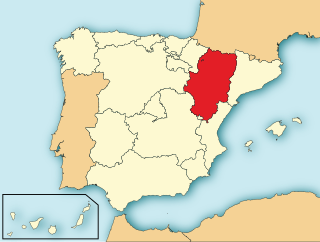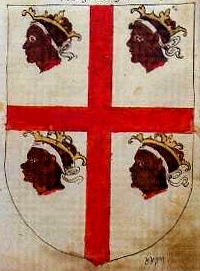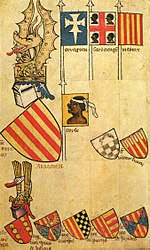
The Count of Barcelona was the ruler of the County of Barcelona and, by extension, the Principality of Catalonia for much of Catalan history, from the 9th century until the 18th century.

The Senyera is a vexillological symbol based on the coat of arms of the Crown of Aragon, which consists of four red stripes on a yellow field. This coat of arms, often called bars of Aragon, or simply "the four bars", historically represented the King of the Crown of Aragon.

The Kingdom of Aragon was a medieval and early modern kingdom on the Iberian Peninsula, corresponding to the modern-day autonomous community of Aragon, in Spain. It should not be confused with the larger Crown of Aragon, that also included other territories — the Principality of Catalonia, the Kingdom of Valencia, the Kingdom of Majorca, and other possessions that are now part of France, Italy, and Greece — that were also under the rule of the King of Aragon, but were administered separately from the Kingdom of Aragon.

The Crown of Aragon was a composite monarchy, also nowadays referred to as a confederation of individual polities or kingdoms ruled by one king, originated by the dynastic union of the Kingdom of Aragon and the County of Barcelona and ended as a consequence of the Spanish War of Succession. At the height of its power in the 14th and 15th centuries, the Crown of Aragon was a thalassocracy controlling a large portion of present-day eastern Spain, parts of what is now southern France, and a Mediterranean "empire" which included the Balearic Islands, Sicily, Corsica, Sardinia, Malta, Southern Italy and parts of Greece.
Louis of Enghien titular Duke of Athens, Count of Brienne and Lord of Enghien in 1381–1394, Count of Conversano in 1356–1394. His coat-of-arms was "Enghien, a label gules bezantee".

The Principality of Catalonia was a medieval and early modern state in the northeastern Iberian Peninsula. During most of its history it was in dynastic union with the Kingdom of Aragon, constituting together the Crown of Aragon. Between the 13th and the 18th centuries, it was bordered by the Kingdom of Aragon to the west, the Kingdom of Valencia to the south, the Kingdom of France and the feudal lordship of Andorra to the north and by the Mediterranean sea to the east. The term Principality of Catalonia remained in use until the Second Spanish Republic, when its use declined because of its historical relation to the monarchy. Today, the term Principat (Principality) is used primarily to refer to the autonomous community of Catalonia in Spain, as distinct from the other Catalan Countries, and usually including the historical region of Roussillon in southern France.

The County of Barcelona was originally a frontier region under the rule of the Carolingian dynasty. In the 10th century, the Counts of Barcelona became progressively independent, hereditary rulers in constant warfare with the Islamic Caliphate of Córdoba and its successor states. The counts, through marriage, alliances and treaties, acquired the other Catalan counties and extended their influence along Occitania. In 1164, the County of Barcelona entered a personal union with the Kingdom of Aragon. Thenceforward, the history of the county is subsumed within that of the Crown of Aragon, but the city of Barcelona remained preeminent within it. Within the Crown, the County of Barcelona and the other Catalan counties developed a common polity known as the Principality of Catalonia.

The coat of arms of Galicia is described in the Spanish Law 5 of May 29, 1984, the Law of the symbols of Galicia.

The Coat of arms of Balearic Islands is described in the Spanish Law 7 of November 21, 1984, the Law of the coat of arms of the Autonomous Community of Balearic Islands. Previously, by Decree of the Interinsular General Council of August 7 and 16, 1978, adopted the coat of arms as official symbol of the Balearic Islands.

The coat of arms of the Valencian Community is the official emblem of the self-government institutions of the Valencian Community. It is based on the armorial achievement used from the reign of King Peter IV to John II, called the Great. In 1978 the former Council of the Valencian Country approved it “...for being the oldest known representative emblem of the former Kingdom of Valencia, that had located on the Xerea Gate of the city of Valencia”.

The so-called Bars of Aragon, Royal sign of Aragon, Royal arms of Aragon, Four Bars, Red Bars or Coat of arms of the Crown of Aragon, which bear four red paletts on gold background, depicts the familiar coat of the Kings of Aragon. It differs from the flag because this latter uses fesses. It is one of the oldest coats of arms in Europe dating back to a seal of Raymond Berengar IV, Count of Barcelona and Prince of Aragon, from 1150.

The national symbols of Catalonia are flags, icons or cultural expressions that are emblematic, representative or otherwise characteristic of Catalonia or Catalan culture.

The bat is a heraldic symbol sometimes used as a charge, but most prominently used as a crest on or around the crown in municipal arms of the former Crown of Aragon—specifically in Valencia, Catalonia and the Balearic Islands.

The Roquefeuil family is one of the most illustrious French noble family. The house of Roquefeuil-Anduze was formed in 1129 after the union between Adelaïs of Roquefeuil and Bernard of Anduze. Heiress of the first Roquefeuil family, Adelaïs inherited from his father and transmitted her family possessions to her son Raymond.
Most of the members of the Capetian dynasty bore a version of the arms of France. The arms of France were adopted by the Capetian kings only in the twelfth century. Consequently, the cadet branches that had branched off in earlier periods bore entirely different arms.

The Catalan Courts or General Court of Catalonia was the policymaking and parliamentary body of the Principality of Catalonia from the 13th to the 18th century.

The Legend of the Four Blood Bars is a legend about the origins of the Senyera Reial that appeared for the first time in 1551 at Segunda parte de la crónica general de España, a chronicle edited by Pere Antoni Beuter in Spanish in Valencia. This legend places the Senyera Reial origins on Wilfred the Hairy. Specifically, it narrates that the sign of the four bars was created after a battle against the Normans, when the King of the Franks doused his hands in the blood of Wilfred the Hairy's injuries. After swiping his fingers over the golden shield of the Earl of Barcelona he said: "These will be your arms, Earl".

The coat of arms of Barcelona is the official emblem of the City Council of Barcelona, the capital of Catalonia, has its origin in the Middle Ages, these arms were first documented in 1329. The Government of Catalonia conferred the coat of arms and the flag as official symbols of the municipality in 2004. It has an escutcheon in lozenge which is commonly used in municipal coats of arms of cities in Catalonia. Currently the City Council of Barcelona also uses an isotype based on the heraldry of the city.

The Cross of Alcoraz is the name given to a heraldic coat of arms and flag made up of the Cross of Saint George, or cross of gules on Argent, with a Maure, or Moor's head, in each quarter. The earliest documented evidence of these arms is in a rare leaden-sealed decree from the chancery of Peter III of Aragon, circa 1281, most likely used as the King's personal coat of arms, alluding to the spirit of the Crusades and his ancestral namesake, Peter I of Aragon. The arms also appear in the third quarter of the current Coat of arms of Aragon.


















